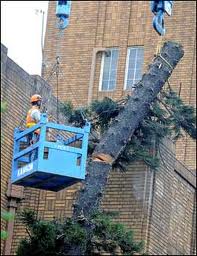The Plight of Hong Kong’s Trees
Posted: September 12th, 2010 | 3 Comments »I hadn’t really thought about the plight of Hong Kong’s trees much to be honest. Shanghai has an erratic history on tree preservation – around the former French Concession and Western Roads Area most remain though large numbers have been felled in the former Hongkew and Yangtzsepoo (Hongkou and Yangpu) areas. Peking has been even more ruthless with its trees – earlier this year I stood with a friend and some hutong residents as a beautiful full grown tree was removed seemingly to provide easier access for cars to a car park – great! It was a sad occasion and some local residents were teary eyed – but the officials decided that a ‘Civilised Chaoyang’ apparently needed to lose many of its old trees to allow for the free movement of combustion engines (apparently a sign of civilization) rather than preserving oxygenators.
I first became aware of the problems trees faced in Hong Kong through an article in Muse magazine in April 2010 – The Tree Professor – about Jim Chi-yung who argued that cutting down Hong Kong’s mature trees was tantamount to demolishing ancient monuments. I couldn’t agree more.
The issue  of tree preservation and Jim Chi-yung (a professor at HKU) has become very public around the pine tree at the Maryknoll Convent School in Kowloon Tong. The School is a preservation site but trees on the site are not covered in the same way as buildings – the 70 year old, 20-meter tree came down in February. Apparently Professor Jim tried to save the tree and a group calling themselves Ghost Pine Organization have filed a petition with the Office of the Ombudsman claiming the tree’s felling was the result of inadequate guidelines and the lack of proper supervision. The group accused the Antiquities and Monuments Office, Development Bureau and Leisure and Cultural Services Department of negligence.
Meanwhile Hong Kong’s trees continue to suffer – here’s a blog post from a concerned Hong Konger about a rubber tree the authorities seem to have taken a particular dislike to on Lantau. Here’s hoping the tree defeats the bureaucrats.
 and down came the Maryknoll pine tree
and down came the Maryknoll pine tree
The Mary Knoll tree incident is a good example of how to bypass official authority or popular opposition to get your own way.
The tree was slated for removal some time earlier but there was a lot of opposition from various groups (including various alumni), so the school authority backed down.
By sheer coincidence a few months later, the tree roots were completely severed during some unapproved maintenance work and thus the tree had to come down anyway.
Moral of the story: if you need to get rid of something on your land, fix it so it becomes too dangerous to remain standing (same applies for preservation-worthy buildings, not just trees).
The roots of Hong Kong trees suffer a lot from the constant digging up of roads and pavements. The authorities don’t even plant large trees any more, preferring palms which can easily be removed when the roads need widening again.
But the public need to change their attitude to trees as well. Hollywood Road has a couple of banyans clinging to the retaining wall of the old Police Married Quarters. Their aerial roots are a lovely sight. But someone complained about them, and now the government has tied all the roots up into bunches. Brilliant.
of course this is a classic trick by landlords and governments the world over – allow something to deteriorate, do nothing to preserve it and make it as difficult and costly as possible for the community to do anything and then declare it a slum or a danger and condemn it. I’ve seen the same trick played everywhere from Glasgow to Singapore and, of course, Shanghai and Peking on a massive scale.